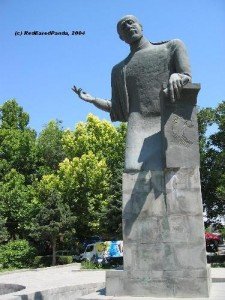By Yervand Kochar
Very few works of art communicate the Armenian spirit—its strength and depth, its continuous pain and inexplicably persistent hope—to the degree it is communicated through the music of Vartabet Komitas and the art of Yervand Kochar.

Komitas and Kochar are, respectively, the musical and imaginative colossuses of the Armenian cultural psyche. Through their tragic lives and magnificent art, these artists manifested the undefeated spirit of the Armenian people and shed some precious light on the mystery of human perseverance against oppressive darkness and violence.
The lives, as much as the art, of Komitas and Kochar are navigational maps of the Armenian experience, a sublime alchemy of transforming a matter of base, brutal circumstances into a gold of spiritual ascendance.
Komitas was a victim of and witness to the Armenian Genocide, an experience that would eventually drive him into a dark corner of insanity and shorten the creative expression of one of the world’s most original and unique composers.
Kochar—a visionary who conquered the artistic Paris of the 30’s through his Painting in Space style, and who left his admirers like Picasso in awe—would end up in the prison cells of Stalin’s demonic regime, banned from full expression and disallowed to paint.
Yet, in spite of torturous lives, Komitas’ music and Kochar’s art have become cornerstones of the great cultural edifice of Armenia and her will to survive.
Composing and performing for Komitas and painting and sculpting for Kochar were not mere acts of creative expression. Their work had a tremendous significance for the development and strengthening of the Armenian identity and happened in spite of the circumstances rather than as their result.
Komitas, a Christian monk in Ottoman Turkey, successfully identified and liberated a distinctly Armenian sound from the cacophony of musical influences and traditions predominant in the region. The lack of Armenian statehood and national expression made Komitas’ work even harder and its success even more important. Being second-class Christian citizens of mostly Islamic dominions, Armenian musicians had very little official and creative freedom to express and identify a pure Armenian sound. The will to preserve the Christian spiritual energy of Armenian music was a dangerous political statement.
In a way, Komitas’ significance for Armenian nationhood was as paramount as Mashtots’ creation of the Armenian alphabet in the 4th century. The creation of the Armenian alphabet guaranteed the preservation of Armenian culture and its Christian identity against the coordinated attempts to assimilate it into the larger matrix of the Persian and Byzantine Empires, thus resulting in its inevitable conversion and destruction.
In the words of Heidegger, “language became the house of our being,” or rather, our language, music, and art became an impregnable castle of our being, guarantors of immunity against conquest and forced or gradual conversion.
The idea that, centuries later, such a monumental task of salvific importance would be once again placed on the shoulders of a seemingly weak and fragile monk such as Komitas is a testament to God’s habit of operating in highly mysterious ways.
Similarly an unlikely candidate, Kochar, a broken man on a verge of suicide, would be oddly chosen to create a symbol of the Armenian spirit (the statue of David of Sassoun), under the pressure and hindrance from yet another hostile and barbaric regime: Soviet Communism. The regime imprisoned and tried to exterminate Kochar by assigning him the suicide mission of creating a national symbol in a time when even a hint of national identity meant death and exile.
The secret of Komitas’ and Kochar’s success in creating lasting and powerful national values was in their ability to draw from the universal pool of knowledge and culture. Komitas’ music is distinctly Armenian, but the vital river that nourishes it is the same river that nourished Beethoven’s music. Kochar’s David of Sassoun is the condensed power of Armenia, but it is also an extension of the same power that gave birth to Michelangelo’s David.
Komitas and Kochar were true Armenian artists precisely because of their universality and inclusiveness. Komitas studied music in Berlin from 1896-99 and absorbed Western and especially German musical traditions just as Kochar studied and created his art in 1930s Paris, being influenced by, influencing, and exhibiting with masters such as Picasso, Miro, Picabia and Chagal.
Both artists were highly acknowledged by their great contemporaries and were poised to become leading voices of world culture. The fact that lives and careers of both artists were derailed by the collective tragedy and suffering of their nation by no means diminishes the true value and significance of their art.
By the Providence of history, years after Komitas’ death in a mental asylum in Paris, Kochar—who was banned from returning to Paris—was commissioned to create a sculpture of Komitas in Edjmiazin, the church-city that had commissioned Komitas’ work in the past.
Today, Komitas’ statue stands vigil in the main square of Edjmiazin.
One would assume that Kochar, who easily identified with Komitas’ inhumane suffering and despair, would depict the great composer as a victim of violent history, a man maddened by the horror of Genocide witnessed.
Yet, Kochar’s Komitas is serene and composed, emanating peace, authority, and quiet power. Kochar’s Komitas is not a victim but a winner, just like Komitas was through his work, just like Kochar himself was through his undefeated spirit, just like the nation that they represented is and will always be—ever refusing to surrender, perish, or cease striving for greatness.
Editor’s Note: Yervand Kochar is a filmmaker based in LA and New York. He is currently producing a movie about a family affected by the denial of the Armenian Genocide, entitled The 13th Image. (www.whatisthe13thimage.com)
great site. Thanks for showing us